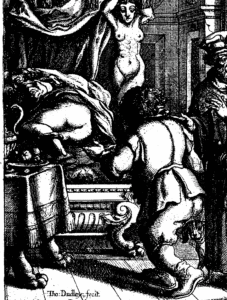A few weeks ago, in late August, I went on one of the most pleasant and thought-provoking research trips I’ve taken recently. Lampeter is a small Welsh town set amid beautiful rolling hills (then somewhat parched after the heatwave of the early summer). It also has a historic University library, founded in the early nineteenth century, which includes among its collections a small but fascinating corpus of early Aphra Behn materials.
Among Lampeter’s Behn holdings is a copy of Aesops Fables (1687). Like many of the library’s early printed books, Aesops Fables was acquired through donation from the educational philanthropist Thomas Phillips (1760-1851). Phillipps, who had also worked as an East India company surgeon, probably did not set out to collect Aphra Behn but procured her works almost by accident, in the course of adding to his ever-growing library. If he was attracted by anything in particular in Aesops Fables, it is likely not to have been Aphra Behn’s poetic versions of the fables – physically, a small component of a large and complex volume – but rather Francis Barlow’s finely executed animal engravings, which are now recognised as a landmark achievement in seventeenth-century book illustration. Although Aesops Fables, compared with many early modern books, is not rare – the British Library alone holds four copies – Lampeter’s copy is remarkably well-preserved, including all the prefatory material in what seems to have been the original order. It does not, however, include plate 17 from the illustrated ‘Life of Aesop’, an image excised from several extant copies on grounds of supposed obscenity (it depicts Aesop’s master’s wife with her buttocks exposed). Whether Aphra Behn wrote the (unattributed) four-line poems accompanying each of the ‘Life’ illustrations, as well as the six-line fables that Barlow explicitly attributed to her in his preface, is among the questions that the Cambridge Behn project hopes in time to be able to answer.

Section of Plate 17. Image from Early English Books Online.
Lampeter’s other Behn holdings comprise political poems: two dating from 1685 (her elegy on Charles II and consolatory poem to Catherine of Braganza), and two from 1689 (A Congratulatory Poem to Her Sacred Majesty Queen Mary, upon her arrival in England and A Pindaric Poem to the Reverend Doctor Burnet). The poem to Gilbert Burnet – propagandist for William of Orange, and future Bishop of Salisbury – is a rare survival, one of only seven copies now known to be extant. I regret to report that I may have been the first person in its 329-year history actually to read the Lampeter witness, as its pages had never been cut.

Recent Comments